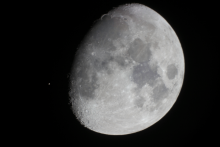Listen to today's episode of StarDate on the web the same day it airs in high-quality streaming audio without any extra ads or announcements. Choose a $8 one-month pass, or listen every day for a year for just $30.
You are here
Moon and Aldebaran
The bull will get an eye patch tonight. As seen from the eastern U.S., the Moon will pass in front of Aldebaran, the eye of Taurus, hiding the star from view. Aldebaran will stand close to the Moon as night falls. The Moon will then close in on the bright star and pass in front of it.
What’s happening inside Aldebaran is always hidden from view. From the star’s size and brightness, though, astronomers have a good idea of what’s going on. Aldebaran has converted the hydrogen fuel in its core to helium. Now, it’s either converting the helium to carbon and oxygen, or it’s just about to.
In fact, that’s how all the carbon and oxygen in the universe were made — in the hearts of stars.
The Big Bang created huge amounts of hydrogen and helium and a tiny smattering of a couple of other elements. But conditions weren’t right for making heavier elements. Conditions are right in the cores of stars, though.
After it’s burned through the hydrogen to make helium, the core shrinks and gets hotter. That creates the conditions necessary for the nuclei of helium atoms to stick together to make carbon and oxygen.
In stars like Aldebaran and the Sun, the process stops there. But in heavier stars, temperatures in the core get even hotter. That allows the stars to make even heavier elements — all the way up to iron. Most of the elements beyond iron are made either in stellar explosions or in even more-exotic environments — acts of alchemy in the stars.
Script by Damond Benningfield



